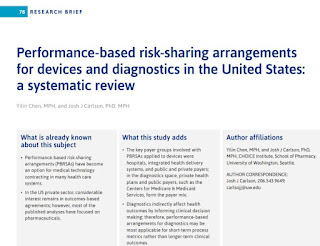In December, I had the chance to give a talk for a major device manufacturer on trends in value based purchasing and managed care. I noted that while there were some exceptions, in many cases, the impact on devices (and diagnostics) is not that large. For example, you will hear that a plan has 99% of its hospitals under value-contracts, and only later discover that the average bonus or penalty was, say, 0.5%. So you can spin that fact set in different ways.
Two interesting follow ups.
#1 What CEO's Call Out as Biggest Trends Aren't "Value Based Purchasing" Metrics
I heard a podcast from physician executive and (former) Senator Bill Frist, A Second Opinion, on December 6. He interviewed Bruce Broussard, CEO of Human, and Glen Tullman, CEO of Transcarent, which aims to electronically enhance care coordination. Tullman was CEO of Livongo.
Asked to name the most impactful trends in healthcare, these leading executives cited major topics like "working to the top of one's license" (e.g. nurse practitioners) and "shift to home-based care" (e.g. so called hospital-at-home programs). These are a wholly different language that most "value based payment" metrics, such as most CMS metrics (e.g. 0.25% penalty for repeat admissions in the second quintile).
#2 Brand New Article on Value-Based Contracting for Devices (But Includes Defunct MolDx LCDs)
But if you do want to have on file something very recent on performance-based contracting for devices and diagnostics, see a new 2022 article by Chen & Carlson in J Managed Care Spec Pharmacy here. See also a blog by Jason Shafrin summarizing the Chen/Carlson report here.
In interpreting this, some "watch-outs."
Many of the data tallied are from "Local CED." Medicare buffs will quickly recognize that most of the arrangements being logged from publicly available sources available to the authors are CED NCDs from CMS, and to a substantial degree, 2015 era "CED" or "CDD" LCDs from Palmetto MolDx. MolDx has not done any CED LCDs for several years and has deleted or isn't enforcing any of the old ones. They may have LCDs with remarks like "We will continue to evaluate the evidence for coverage" but that isn't a formal agreement that should be counted as a contract for "value based purchasing." So be aware of this paper, but note such caveats in interpreting it in any forward-looking way. For example, authors write that '"A key player in the diagnostics arena (for value based purchasing) has been Palmetto GMS, with its data development program, which is a version of CED." Another point is that CMS NCDs with CED are disproportionately devices, not drugs, but CMS publishes almost no NCDs on drugs to begin with.
Acronym to remember - PBRSA, performance-based risk-sharing agreement.
Postscript.
In March 2022, I was writing a colleague about this report, and quoting myself, I had this point on national CED:
A more important question would be how often NCDs with CED have resulted in anything useful. The examples most often mentioned are things like TAVR but I think the "CMS CED" actually matched the FDA registry or FDA trial requirements anyway. How often have CED NCDs actually resulted in CED being started? How often published? How often has the NCD of a CED-containing NCD changed? And in a way clearly tied to the CED therein? Those would be valuable questions about the value of CED. I suspect it would look mediocre at best. CMS never reports on this, even as it is constantly touting its interest in expanding CED such as in recent discussions of "TCET" or Transitional Coverage for Emerging Technologies."
